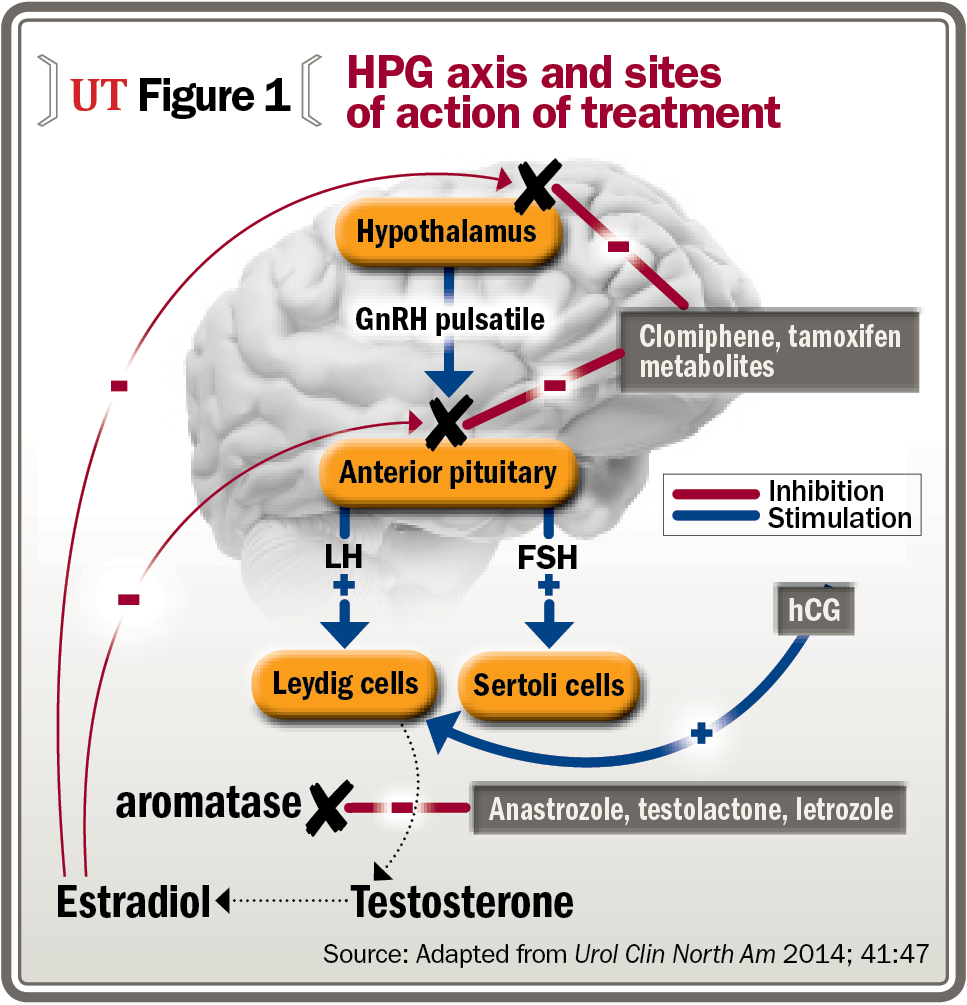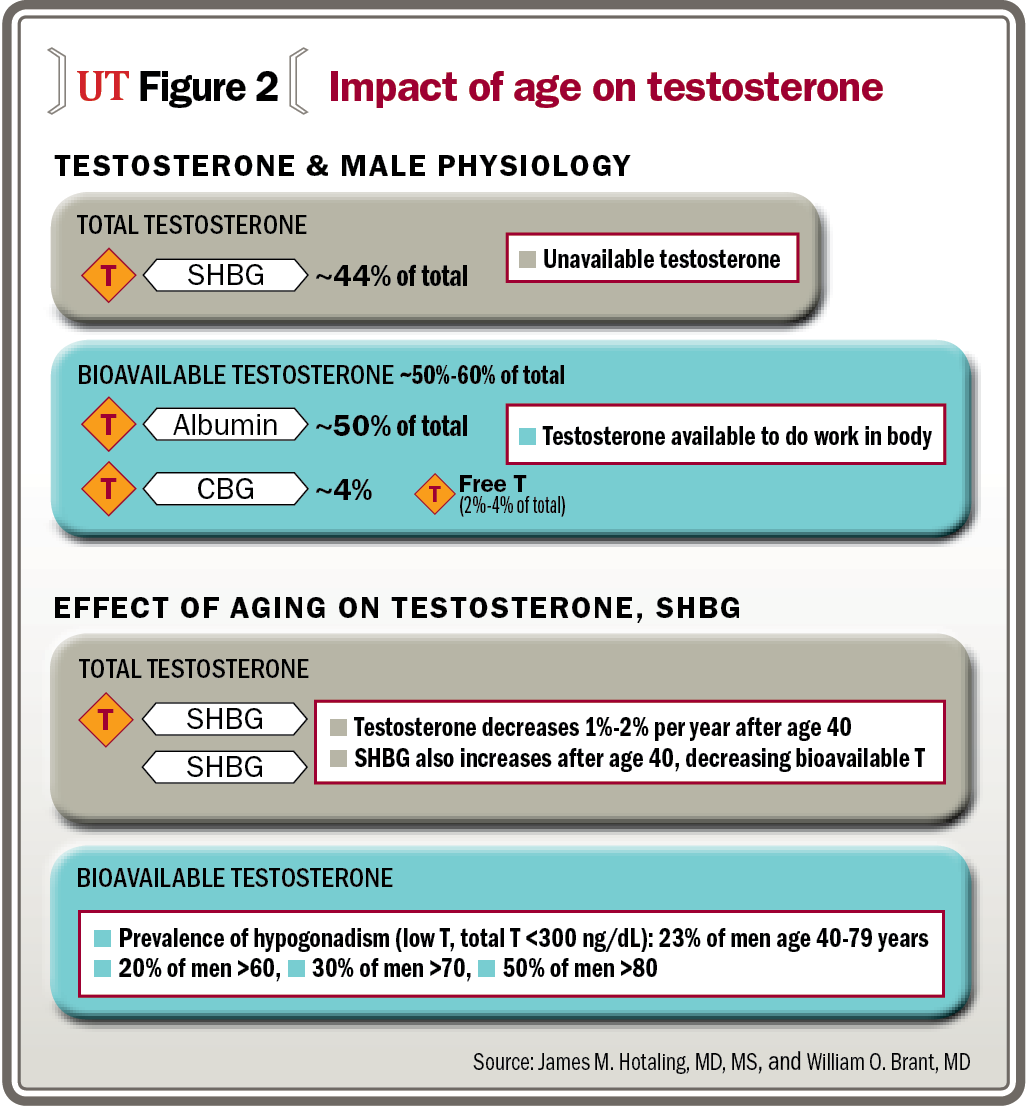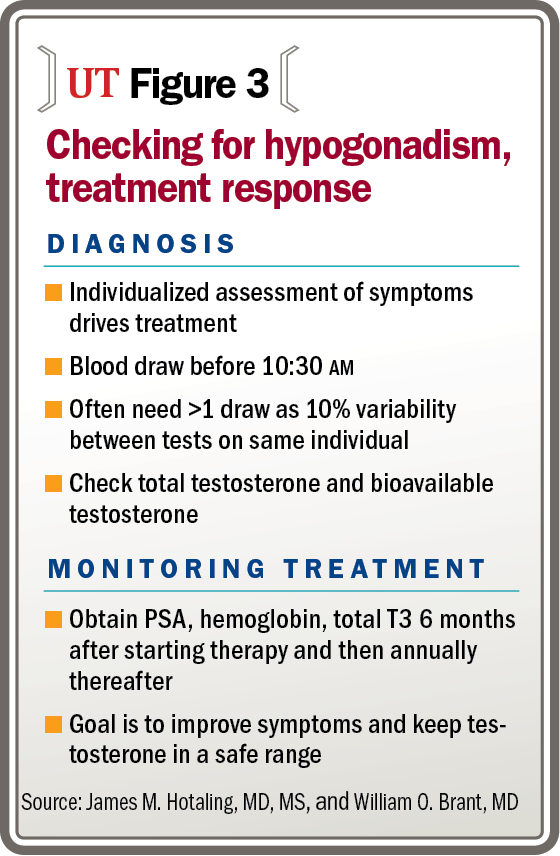Article
Alternatives to T therapy: Lessons from male infertility
Whatever the exact mechanism of the increase in desire for testosterone replacement therapy in men, knowing the risks and benefits of testosterone and its alternatives are vital skills for today’s practicing urologist. This article will focus on alternatives to testosterone therapy.



Testosterone use in the United States is currently rising at unprecedented levels. Annual testosterone prescriptions have increased more than fivefold from 2000 to 2011, resulting in $1.6 billion in revenue and 5.3 million testosterone prescriptions in 2011 alone (FDA Bone, Reproductive and Urologic Drugs Advisory Committee [www.fda.gov]; Nature Rev Endocrinol 2013; 9:414-24). Perhaps the best evidence of the success of testosterone therapy has been the recent Time cover article on “manopause” and the fact that the marketing campaign for “low T” is now taught at Harvard Business School as an example of the most successful marketing campaign in the history of medicine.
RELATED: Men’s health: The argument for a holistic approach
All of this has meant that urologists are now more than ever on the front lines of men’s health. Both the desire to preserve the youthfulness of an aging baby boomer population and a younger population seeking a competitive edge in the work force-and in play-drive our patients to seek treatment. Or, perhaps, as Albert Einstein said, “Even our destiny is determined by the endocrine glands,” and men are just becoming aware of this.
Whatever the exact mechanism of the increase in desire for testosterone replacement therapy in men, knowing the risks and benefits of testosterone and its alternatives are vital skills for today’s practicing urologist. This article will focus on alternatives to testosterone therapy.
Why alternatives to T?
Male infertility specialists frequently manipulate the hypothalamic-pituitary-gonadal (HPG) axis in order to treat primary endocrine derangements or counteract the deleterious impact of exogenous testosterone on spermatogenesis (Urol Clin North Am 2014; 41:39-53). In order to appropriately manage hypoandrogenism, it is necessary to understand the HPG axis and the risks and benefits of the off-label use of female fertility agents in men (figure 1).
Next: Impact of age on testosterone

An understanding of the impact of age and relationship of total, free, and bioavailable testosterone as well as estradiol and sex hormone binding globulin (SHBG) is also necessary (figure 2). Male aging is associated with a decrease in total testosterone and an increase in SHBG with a net effect of decreasing the bioavailable and free testosterone (J Clin Endocrinol Metab 2002; 87:589-98;J Clin Endocrinol Metab 2008; 93:2737-45). Given the well-known variability in free testosterone levels based on the assay used, we have used bioavailable testosterone as a screening tool for equivocal testosterone values and have typically followed PSA, HCT, and T (figure 3). For patients who are not obtaining lab tests within our men’s health center, we will calculate the bioavailable testosterone based on testosterone, SHBG, and albumin (J Clin Endocrinol Metab 1999; 84:3666-72).

The most common reason that patients desire alternatives to testosterone therapy is fertility preservation. Many patients, and up to 25% of urologists based on a survey at AUA 2014, incorrectly believe that fertility will be improved through use of exogenous testosterone. Other common reasons are testicular hypotrophy, intolerance of the variability in testosterone levels associated with injection therapy, polycythemia, and mood instability. Typically, we monitor testosterone therapy with a PSA, hematocrit, and total testosterone at 3 and 6 months and then annually. Prior to initiating alternatives to testosterone therapy, we check levels of total testosterone, bioavailable testosterone, and estradiol.
Clomiphene
For patients desiring alternatives to testosterone therapy, our first-line medication is clomiphene citrate (Clomid), assuming the testosterone:estradiol ratio is greater than 10:1 and the patient does not have an estradiol >60 pg/mL. This medication works by blocking estrogen receptors at the level of the hypothalamus, is considered a selective estrogen receptor modulator, and is FDA approved for the treatment of ovulation induction in women. Clomiphene is well studied as a male infertility drug for men with hypoandrogenism, and studies have shown that it is safe and well tolerated (BJU Int 2012; 110:573-8;Urol J 2010; 7:188-93).
We begin with clomiphene, 50 mg every other day (so patients do not have to split the pill in half), and repeat an endocrine analysis consisting of testosterone, SHBG, albumin (to calculate the bioavailable testosterone), and estradiol. If the estradiol is >60 pg/mL and bioavailable testosterone is >200 ng/dL with good symptomatic relief, we will decrease the clomiphene dose to 25 mg every other day. If the estradiol is >60 pg/mL and bioavailable testosterone is <200 ng/dL, we will switch the patient to an aromatase inhibitor with a goal of a testosterone:estradiol ratio of 10-20:1 (see below). Clomiphene is titrated up to 100 mg daily, repeating labs 2 weeks after each dosing change as necessary to achieve both symptomatic relief and bioavailable testosterone at least above 200 ng/dL.
Once the patient is on a stable dose of clomiphene, we repeat a hematocrit, testosterone, and PSA every 3 months for a year and then annually for the duration of clomiphene therapy. Clomiphene is generally well tolerated, but some patients do not respond or have a paradoxical response (~6%), hence the need for rechecking labs 2 weeks after each change in dosing. Although there are no clear data on the subject, we have found that clomiphene provides only 75% to 80% of the symptomatic relief that men get with testosterone therapy.
Aromatase inhibitors
Should a patient have a testosterone:estradiol ratio less than 10:1 or hyperestrogenemia (estradiol >60 pg/mL), we typically initiate therapy with an aromatase inhibitor. Aromatase inhibitors work by blocking aromatase, which converts testosterone to estradiol, thus decreasing estradiol levels and reducing negative feedback. We use anastrazole (Arimidex), which we have found to be safe and effective, although some centers use letrozole (Femara).

Anastrazole, 1 mg daily, is prescribed, and we follow the same protocol as described for clomiphene but obtain a bone scan after 1 year of therapy due to the risk of osteopenia associated with decreased estradiol levels. Further, unlike clomiphene, where we commonly maintain therapy for patients for years, we attempt to keep the duration of anastrazole therapy less than 1 year due to the risk of osteopenia.
Next: Human chorionic gonadotropin
Human chorionic gonadotropin
If we are unable to make a man euandrogenic with clomiphene or an aromatase inhibitor, we move on to human chorionic gonadotropin or hCG. The reason this is a third-line drug for us is its high cost: $200-$400 per month versus clomiphene and aromatase inhibitors, which cost tenfold less.
We typically begin with 1,500 IU of hCG SC twice a week. hCG works on the Leydig cells to stimulate testosterone production. hCG is generally well tolerated and efficacious. While some have advocated using hCG in conjunction with testosterone to preserve testicular size, we have not employed this approach. However, we will use hCG in conjunction with anastrazole if men develop hyperestrogenemia while on hCG.
Conclusions
We counsel men who are either actively pursuing pregnancy or have fertility as a near-term goal to avoid all exogenous testosterone. We have found that transitioning men from testosterone therapy to fertility-preserving medications such as clomiphene, anastrazole, or hCG is an iterative process that requires personalized treatments and multiple clinic visits. However, with this approach, we are able to transition nearly all men from testosterone to alternative therapy, although patients will rarely achieve the same degree of symptomatic relief.
Typically, it takes 3 to 9 months for spermatogenesis to return after transitioning men off testosterone and on to alternative forms of therapy. However, if men have taken anabolic steroids and have testosterone levels above 1,500 ng/dL, we counsel them that they may not ever see a full recovery of their androgenic axis. We do not routinely prescribe any over-the-counter supplements to men transitioning off testosterone therapy.
Subscribe to Urology Times to get monthly news from the leading news source for urologists.
















